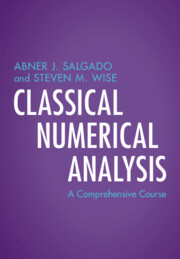Book contents
- Frontmatter
- Contents
- Preface
- Acknowledgements
- Symbols
- Part I Numerical Linear Algebra
- Part II Constructive Approximation Theory
- 9 Polynomial Interpolation
- 10 Minimax Polynomial Approximation
- 11 Polynomial Least Squares Approximation
- 12 Fourier Series
- 13 Trigonometric Interpolation and the Fast Fourier Transform
- 14 Numerical Quadrature
- Part III Nonlinear Equations and Optimization
- Part IV Initial Value Problems for Ordinary Differential Equations
- Part V Boundary and Initial Boundary Value Problems
- Appendix A Linear Algebra Review
- Appendix B Basic Analysis Review
- Appendix C Banach Fixed Point Theorem
- Appendix D A (Petting) Zoo of Function Spaces
- References
- Index
9 - Polynomial Interpolation
from Part II - Constructive Approximation Theory
Published online by Cambridge University Press: 29 September 2022
- Frontmatter
- Contents
- Preface
- Acknowledgements
- Symbols
- Part I Numerical Linear Algebra
- Part II Constructive Approximation Theory
- 9 Polynomial Interpolation
- 10 Minimax Polynomial Approximation
- 11 Polynomial Least Squares Approximation
- 12 Fourier Series
- 13 Trigonometric Interpolation and the Fast Fourier Transform
- 14 Numerical Quadrature
- Part III Nonlinear Equations and Optimization
- Part IV Initial Value Problems for Ordinary Differential Equations
- Part V Boundary and Initial Boundary Value Problems
- Appendix A Linear Algebra Review
- Appendix B Basic Analysis Review
- Appendix C Banach Fixed Point Theorem
- Appendix D A (Petting) Zoo of Function Spaces
- References
- Index
Summary
We study the problem of polynomial interpolation. Its solution with the Vandermonde matrix, and with a Lagrange nodal basis are then presented, and error estimates are provided. The Runge phenomenon is then illustrated. Hermite interpolation then is studied, its solution is given, and error estimates are provided. The problem of Lagrange interpolation is then generalized to the case of holomorphic functions on the complex plane, and error estimates are provided. A more efficient construction, via divided differences, is then given for the interpolating polynomial. We extend the notion of divided differences, in order to use them to provide error estimates for polynomial interpolation.
Keywords
Information
- Type
- Chapter
- Information
- Classical Numerical AnalysisA Comprehensive Course, pp. 231 - 265Publisher: Cambridge University PressPrint publication year: 2022
